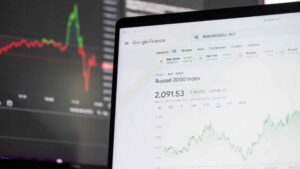European stocks have performed well in Q2, where EU stocks posted strong earnings for five consecutive quarters, but continued to face challenges due to US tariffs in Q2.
Despite currency volatility and ongoing trade uncertainties, sectors like financials and healthcare in Europe performed well while consumer stocks showed weakness. The recent US-EU trade deal offered relief, but risks remain as tariffs continue to impact both exporters and investor sentiment.
Sluggish Growth with Positive Outlook
European stocks outperformed US stocks in Q1, after years of underperformance, as markets shifted away from US stocks due Trump’s unpredictable trade policies.
However, European stocks came up short on earnings in Q2, where they underperformed US stocks, as the S&P 500 grew almost 9% YoY in Q2, as the boost in growth was fueled by strong performances in tech and banks. ⁽¹⁾
Despite this, EU stocks remained optimistic, with 30% of European stocks raising guidance and few downgrading, indicating optimism in future growth. ⁽²⁾
Rise in Euro Presents Challenges for Exporters
The Euro has risen 15% against the US dollar due to tariffs, which has hurt European exporters. Analysts from Barclays and Citi expect an additional appreciation of 10% in the Euro, which could create more challenges in EU stocks such as materials and energy. ⁽³⁾
Many European stocks have stated that volatility in the Euro has impacted earnings. US exporters however, have benefited from a weak USD, as it boosts exports from the US hence increasing earnings. The rise in the Euro has added pressure on European companies which have been already trying to grapple with tariffs. ⁽⁴⁾
Financial Sector Resilience
European financial stocks led the way in growth, with major banks such as BNP Paribas, UBS and Deutsche Bank have beaten analysts’ forecasts, with strong trading performances and optimistic guidance which pushed the banking sector to its highest level since 2008. Financial markets are speculating that the banking sector could continue to withstand tariff risks. ⁽⁵⁾
Healthcare Sector Remains Strong with an Uncertain Future
The healthcare sector has performed well in Q2, contributing 15% growth in earnings, but markets are cautious due to US President Trump’s tariff rate of 250% on pharmaceutical imports. Healthcare stocks have been trading with caution as the sector is still assessing the impact of US pricings on pharmaceuticals. ⁽⁶⁾
Consumer Sector Struggles
Consumer stocks such as luxury and staples have been under pressure from tariffs and changes in consumer spending. Weak earnings results and outlooks have caused the sector to perform weak. Adidas stock declined 18% after warning of price hikes in the US. Luxury stocks saw declines after some companies announced price cuts in the US, stating that the sector is vulnerable to trade policies and demand. ⁽⁷⁾
Tariff Impacts and Trade Deal
US tariffs continue to cause trouble in Europe, with a 39% tariff on Switzerland and a 15% tariff on EU goods starting in September. Companies like Mercedes-Benz and Volkswagen have issued warnings on tariff impacts in their guidance, as automobile manufacturers are facing the most impact from forecasts cuts due to tariffs, especially when Trump announced a 25% tariff on non-US made cars. ⁽⁸⁾
The framework trade agreement with the EU, which sets out a 15% import tariff, will apply broadly to EU goods from next month. But the trading bloc is still waiting on executive orders that would bring down the tariff on some products. ⁽⁹⁾
Before the agreement, US President Trump’s tariff policies have changed frequently since April, the most common start of the second fiscal quarter. Some were imposed while others were proposed and then delayed.



